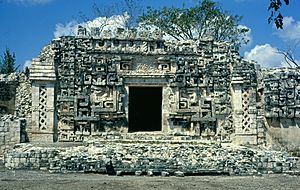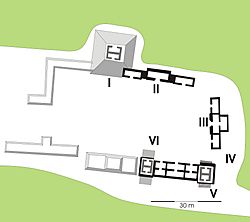Hochob facts for kids
Hochob is an ancient Maya city in the Mexican state of Campeche. It's about a 10-minute drive from the city of Dzibalchén, in an area known as the Chenes region.
The first person to tell the world about Hochob was an explorer named Teobert Maler. He visited the site in 1887 and shared his photos in a magazine called Globus in 1895.
This ancient city was built on top of a natural hill, which was about 30 meters (almost 100 feet) high. The top of the hill was flattened to create a base for all the buildings. The main part of the site is about 200 meters (650 feet) long from east to west and 50 meters (160 feet) wide from north to south.
The buildings at Hochob have amazing decorations in the "Chenes" style. They feature large and small stone blocks carefully placed to form huge masks of the god Itzamná. These masks often have open jaws that look like the entrance to the buildings. Inside, there were likely temples, rooms, and places for priests.
You can even see a life-size copy of one of Hochob's main building fronts at the National Museum of Anthropology in Mexico City.
What Does "Hochob" Mean?
The name Hochob comes from the Maya language. It means "place of the corncobs."
When Was Hochob Built?
While we don't have exact dates, experts believe Hochob was most likely active during the Late Classic period of Maya history. This was around the year 800 AD.
Exploring the Main Buildings
The site of Hochob has several important buildings grouped around three main plazas. Plaza I, also called the Main Plaza, has buildings on its east, north, and south sides.
- Palace of the East (Structure I). This building has three rooms and is about 22 meters (72 feet) long. The front of its central part looks like a giant animal mask that surrounds the entrance. The sides of the building are mostly smooth, with simple horizontal decorations.
- Main Palace (Structure II). This building has a front divided into three sections. The middle section features a huge mask of the god Itzamná. You can see his wide eyes and frowning forehead above the entrance. Large ear decorations are on the sides. The entrance itself looks like the open jaws of the Monster of the Earth, with a small platform forming its lower jaw and fangs at the ends. The corners of the building are decorated with many masks of Chaac, the rain god, seen from the side. On top, there are still parts of a decorative roof comb. The rooms on the sides also have animal masks above their entrances. This building is one of the best examples of the "Chenes" architectural style. Behind Structure II, you can find holes in the ground called chultunes. The ancient Maya used these to collect, store, and share rainwater.
- Structure III. This building is special because it has tall towers topped with fake temples. These towers also have fake stairways, which is a common feature of the "Río Bec" architectural style.
- Structures V and VI. These two structures form a temple complex at each end of a building with six rooms. Unlike Structure III, the stairways leading to the temples here are real and can be used, though they are very steep. The rooms inside the temples have arched ceilings. Their walls are mostly flat, decorated only with stones that stick out above the moldings. These stones might have once held stucco sculptures.
See also
 In Spanish: Hochob para niños
In Spanish: Hochob para niños
- Becan
- Calakmul
- Campeche
- Maya civilization
- Dzibilnocac
- Edzna
- Hormiguero



